

Ways to think for gifted students. Two lesson plans for gifted education. Gifted resources for critical thinking. Gifted resources on creativity. Popcycle sticks. Sentence Frames. Vocabulary Cartoon. Transition Words. Exit Slips. Visual imagry. Summerizing. Anticipation Guide. Venn Diagrams. Alaphebet Matching. Paragraph Hanburger. Reader's theatre. Using the arts to build preposition vocabulary: Things for a meal. Paragraph Shrinking. Reciprocal Teaching. Concept Maps. Syllable Games. Choral Reading. Word Maps. List-group-label. Descriptive Writing. Math through Movement. Picto-spelling. Compound words. How to implement VTS. Home - Visual Thinking Strategies. Classroom Strategies.
ARTSEDGE: Supporting Individual Needs: Supporting ELLs with the Arts. Getting Started You don’t have to be an artist yourself—though everyone is, whether they know it or not—to open the door to using arts as a way to support your English language learners throughout the curriculum.
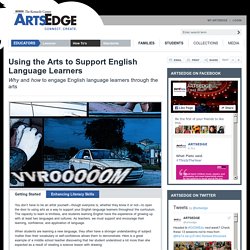
The capacity to learn is limitless, and students learning English have the experience of growing up with at least two languages and cultures. As teachers, we must support and encourage their learning, confidence, and application of language. Building Vocabulary Of ELLs By Talking About Art. Untitled Document. Volume II - 1994 The Role of Art in Language Learning by Catriona R.
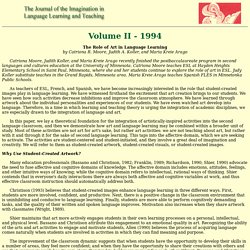
Moore, Judith A. Language through Art (Beginning Level) Welcome to the beginning level of the J.
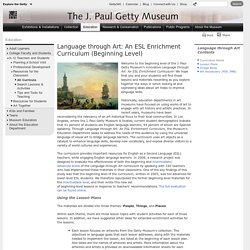
Paul Getty Museum's innovative Language through Art: An ESL Enrichment Curriculum! We hope that you and your students will find these lessons and materials rewarding as you explore together the ways in which looking at and expressing ideas about art helps to improve language skills. Historically, education departments in art museums have focused on using works of art to engage with art history and artistic practices. Is Your Classroom ELL-Friendly? Guest post by Deb Hanson of Crafting Connections Do you have any ELLs in your classroom this year?

According to the National Center for Education Statistics, an estimated 4.4 million students in the United States are ELLs (English Language Learners)! Today I invite you to ponder some questions in order to determine whether your classroom is as ELL-friendly as it could be! Crafty Teacher Lady: Critical Thinking Skills Posters. Hello everyone out there in blog-land!
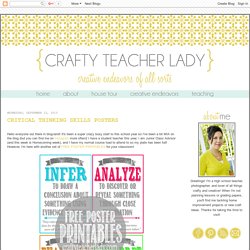
It's been a super crazy busy start to this school year so I've been a bit MIA on the blog (but you can find me on Instagram more often)! I have a student teacher this year, I am Junior Class Advisor (and this week is Homecoming week), and I have my normal course load to attend to so my plate has been full! However, I'm here with another set of FREE POSTER PRINTABLES for your classroom! As a social studies teacher, I'm always seeking ways to work on my students' critical thinking skills. iTeach Third: Vocabulary Support. Hi!
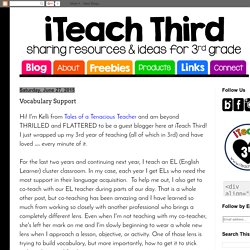
I'm Kelli from Tales of a Tenacious Teacher and am beyond THRILLED and FLATTERED to be a guest blogger here at iTeach Third! I just wrapped up my 3rd year of teaching (all of which in 3rd) and have loved nearly every minute of it. For the last two years and continuing next year, I teach an EL (English Learner) cluster classroom. In my case, each year I get ELs who need the most support in their language acquisition. *FREE* Prepositions Printable - Life of a Homeschool Mom. Life of a Homeschool Mom Balancing Marriage, Motherhood, Homemaking, and Home Education *FREE* Prepositions Printable.
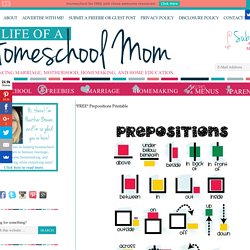
Learning Specialist and Teacher Materials - Good Sensory Learning. Did you know that comfort foods such as ice cream, chips, cereal, and cookies can impact children's health, behaviors and ability to learn?
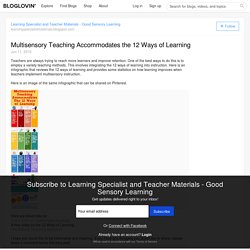
As a child, I learned that I was allergic to preservatives, and once I got off of processed foods, I felt tremendous cognitive gains. There is a multitude of reported, dietary remedies for students with learning disabilities and ADHD, however, what works for one individual often does not work for another. The reason for this is that each individual has their own background, genetic makeup, and sensitivities. As a result, finding a natural remedy can be a bit of a process, but I believe that it is best to address the cause then to treat the symptoms with medications. Do Allergens/Intolerances Impact the Brain? In Praise of Think-Pair-Share. Think-pair-share has gotten a bad rap.
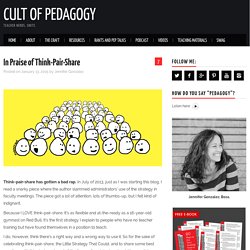
In July of 2013, just as I was starting this blog, I read a snarky piece where the author slammed administrators’ use of the strategy in faculty meetings. The piece got a lot of attention, lots of thumbs-up, but I felt kind of indignant. Because I LOVE think-pair-share. It’s as flexible and at-the-ready as a 16-year-old gymnast on Red Bull. It’s the first strategy I explain to people who have no teacher training but have found themselves in a position to teach.